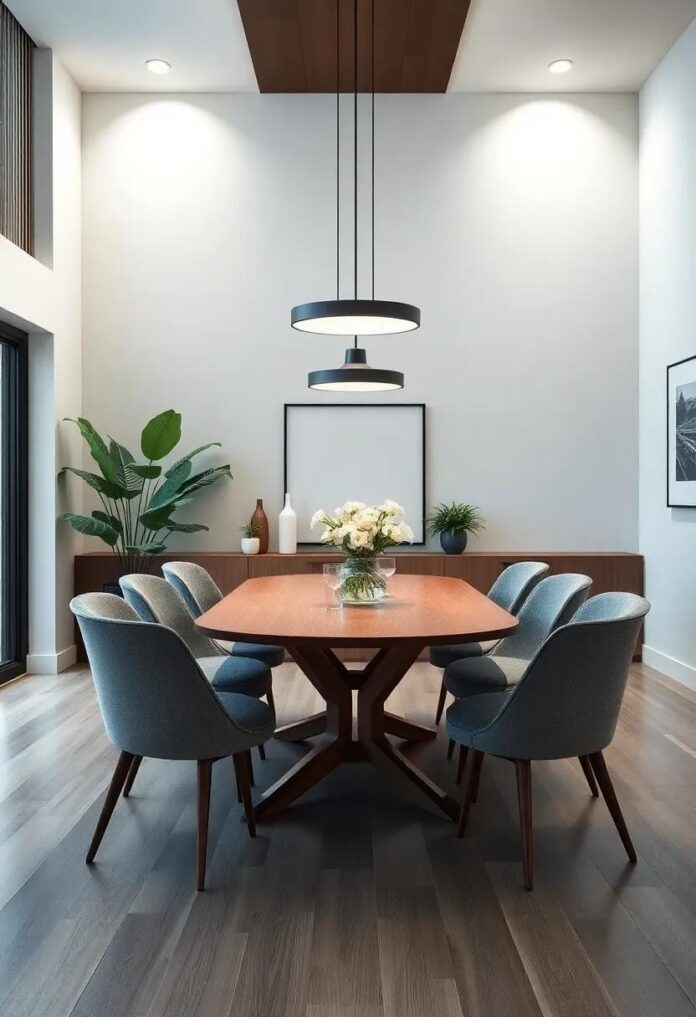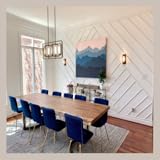In the realm of interior design, few styles resonate with timeless elegance and effortless sophistication quiet like Mid-century Modern.With its clean lines, organic forms, and functional beauty, this aesthetic finds a unique harmony that elevates any space it graces. The dining room, a pivotal gathering place in our homes, offers the perfect canvas to explore and embrace this design ethos. Whether you’re hosting family dinners or sharing quiet breakfasts, incorporating Mid-Century Modern elements can transform your dining area into a sanctuary of style and comfort.In this article, we’ll delve into the allure of Mid-Century Modern elegance, guiding you on a journey to reimagine your dining room with iconic furniture, thoughtful decor, and a seamless blend of past and present. Prepare to unlock the potential of your space,where every meal becomes a party of design.
Transforming Atmospheres with Bold Color Palettes in Dining Room Designs
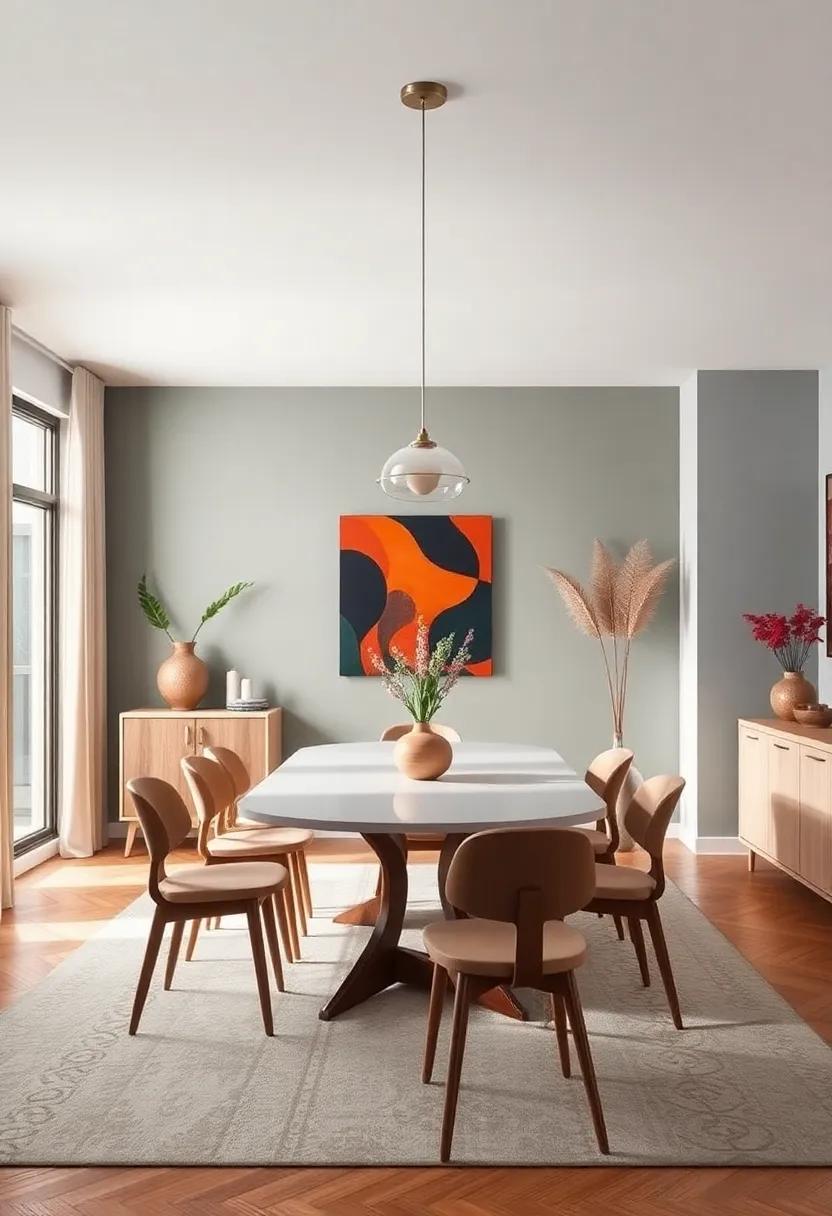
Infusing vibrant hues into a dining room can transform the space from conventional to captivating. By leveraging bold color palettes, the mood of the dining area can be elevated, creating an inviting atmosphere that stimulates conversation and culinary enjoyment. Consider combining shades such as emerald green with mustard yellow, or pairing a striking cobalt blue with soft coral accents. These combinations not only honor the principles of mid-century modern design but can also serve as a backdrop for stunning furniture pieces and decor that embody both form and function. To further enhance the effect, incorporating elements like geometric patterns through textiles or artwork will complement and reinforce the spirited color choices.
When it comes to selecting the right colors, it’s essential to consider the overall aesthetic and functionality of the dining space.A well-planned color scheme can harmonize with chosen furnishings, creating a cohesive look that is pleasing to the eye. Below are some practical tips for selecting colors:
- Accent Walls: Choose one wall to feature a bold color while keeping other walls neutral.
- Color Blocking: Use two contrasting colors to create a dynamic yet balanced aesthetic.
- Textiles and Accessories: Incorporate colorful table runners, placemats, and cushions to enhance the palette.
Moreover,the strategic use of color can also define zones within the room,making the space versatile and engaging.As an example, a vibrant area rug can anchor the dining table, while colorful seating options can introduce an element of playfulness. To illustrate this point further, take a look at the table below which showcases effective color combinations:
| Color Pairing | Vibe | Suggested accents |
|---|---|---|
| Emerald Green & Mustard Yellow | Elegant & Warm | Brass Fixtures |
| Cobalt Blue & Coral | Fresh & Inviting | White Ceramics |
| Terracotta & Soft Gray | Earthy & Calm | Indoor Plants |
Sleek Lines and Organic Shapes: Fundamental Features of Mid-century Modern Style
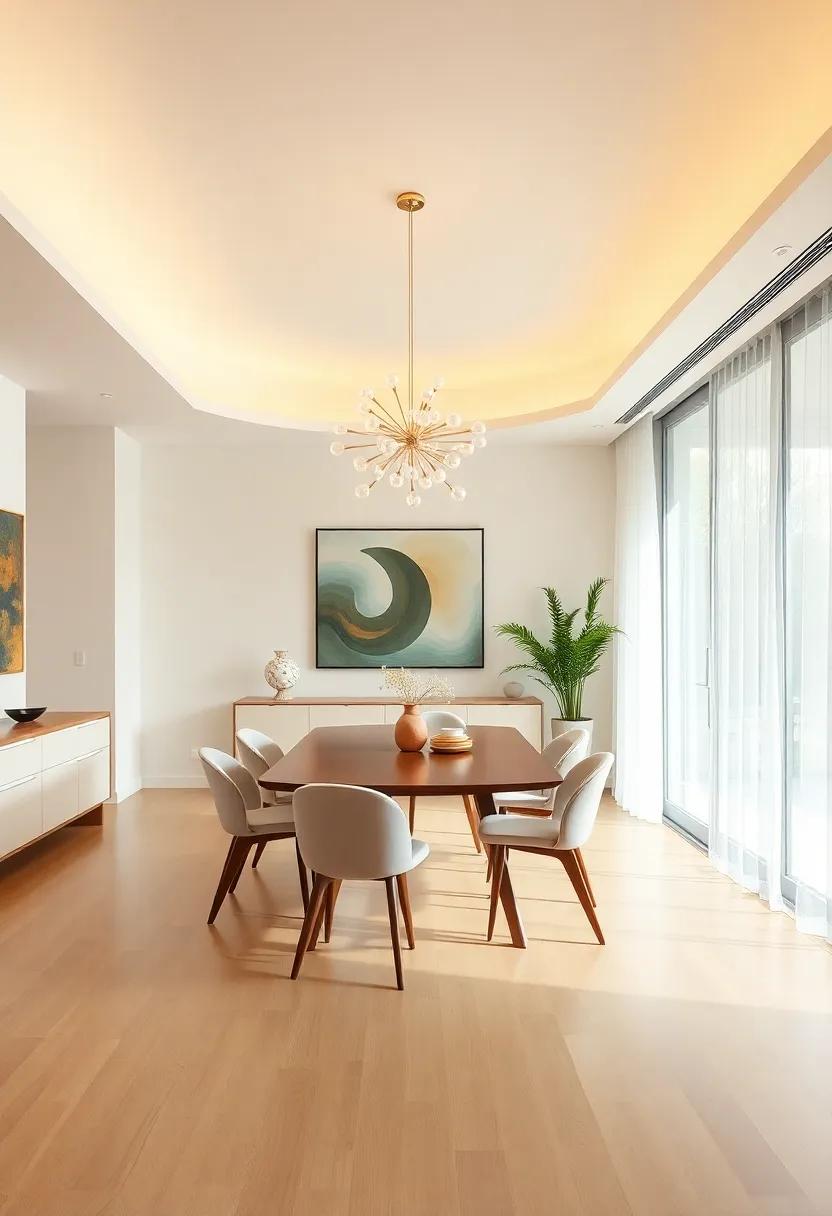
Mid-century modern design captures a unique aesthetic, characterized by an exquisite harmony of form and function. Sleek lines are paramount, incorporating minimalist silhouettes that evoke elegance while maximizing visual appeal. This style often favors geometric shapes,eschewing unneeded ornamentation,which allows pieces to stand out as functional art. When designing your dining room, consider the enchanting allure of furniture with tapered legs and soft curves, creating an inviting atmosphere for both family meals and refined gatherings.
The contrast of organic shapes further complements this design ethos, offering a sense of warmth and connection to nature.Think of dining tables that boast rounded edges, soft contours, or even asymmetrical forms that challenge traditional norms. To enhance this aesthetic, integrate complementary elements such as:
- Natural woods like teak and walnut
- Curvaceous lighting fixtures that cast a gentle glow
- Textured textiles in muted, earthy tones
These features coalesce to form an inviting and timeless dining space that embraces the seamless blend of artistry and practicality that mid-century modern style embodies.
Incorporating Iconic Furniture: Celebrating the Classics of Mid-Century Design
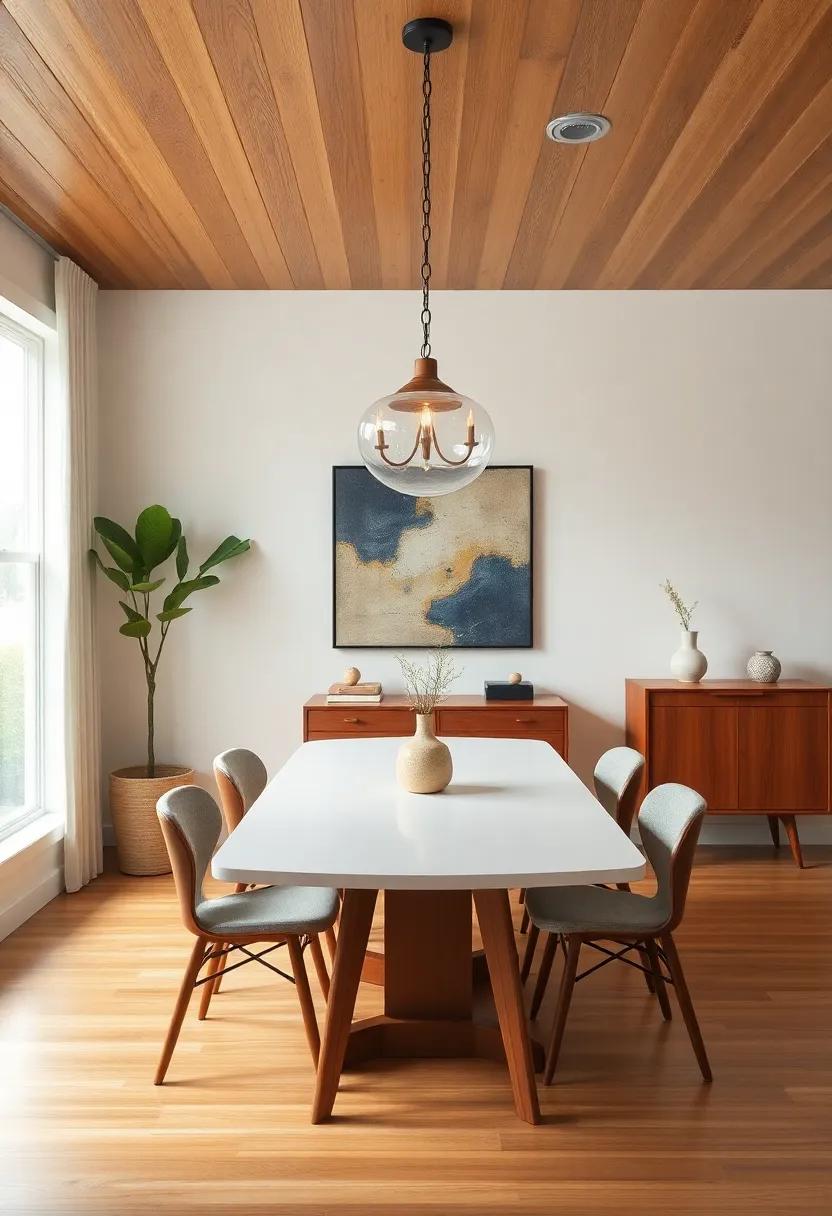
In the realm of dining room design, incorporating iconic furniture pieces from the mid-century era elicits a sense of nostalgia and sophistication. When selecting furniture, consider key elements that not only echo the aesthetics of the time but also enhance the functionality of your space. Famous designs such as the Eames molded chair or the Saarinen tulip table are not mere relics; they are pieces of art that serve a purpose while grounding your dining room in historical importance. To create a cohesive look, choose a color palette that reflects the natural tones of wood and the vibrant hues popular during this time, ensuring that each piece harmonizes beautifully without compromising individuality.
To elevate your dining area, think beyond the basics. Mid-century furniture frequently enough features distinct qualities that can transform a simple setting into a personalized haven. Here are a few recommendations for selecting standout pieces:
- Wood Finishes: Opt for warm, rich woods like walnut or teak to maintain an organic feel.
- Geometrics: Look for furniture with clean lines and geometric shapes that add an architectural flair.
- Textiles: Incorporate bold and vibrant fabrics for cushions and upholstery to infuse personality.
- Lighting: Pair your furnishings with iconic lighting fixtures that enhance the ambiance,such as a starburst chandelier.
Consider this simple table to assist in your selection process:
| Furniture Piece | Key Feature | Color Palette |
|---|---|---|
| Eames Lounge Chair | Iconic comfort with curved lines | Wood tones + muted leather |
| Womb Chair | Cocooning shape for relaxation | Bold fabrics + classic hues |
| Tulip Dining Table | Streamlined and functional | White base + wooden top |
Creating Balance with Minimalist Décor and Statement Pieces in the Dining Room
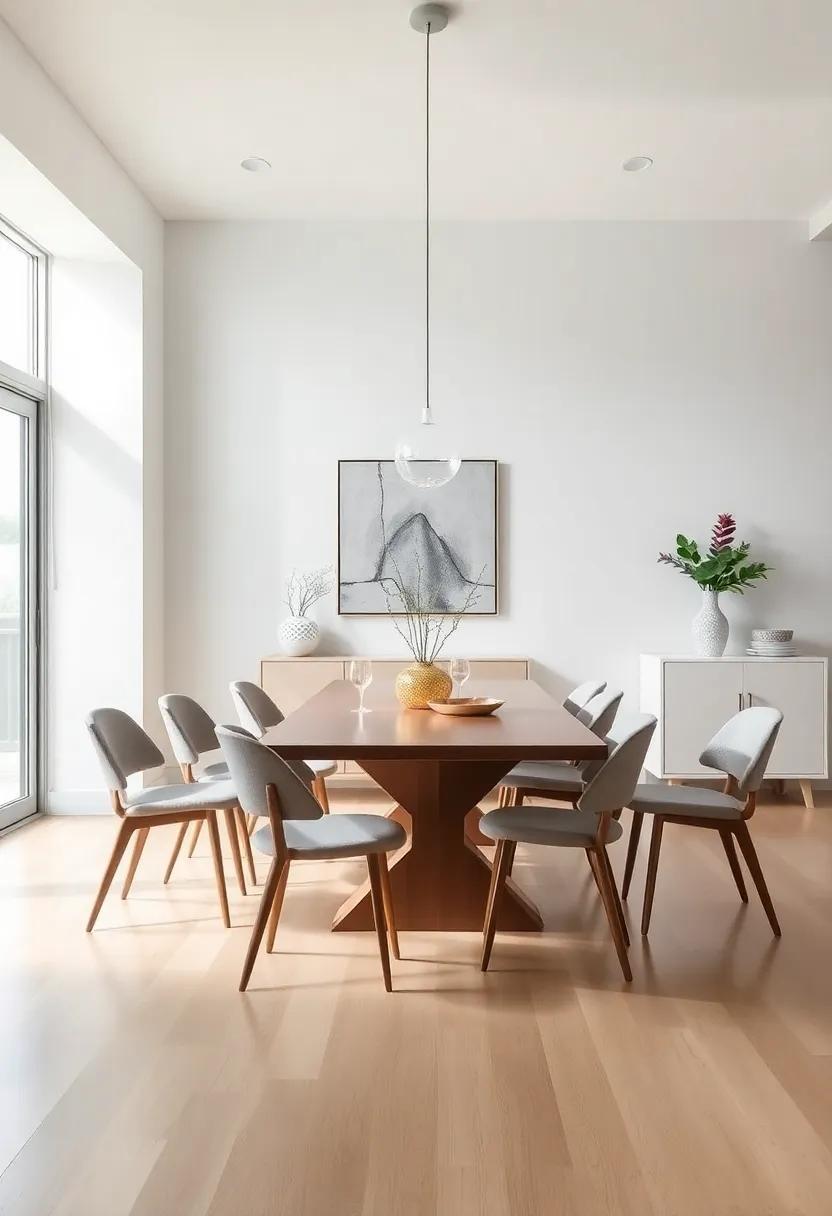
achieving harmony in your dining room can be a delightful design challenge, where minimalist décor mingles with striking statement pieces. A clean, uncluttered space allows for a few select items to shine, enhancing their visual impact. Consider incorporating a sleek dining table in warm woods or rich hues typical of the mid-century modern style, complemented by thoughtfully chosen chairs that echo the aesthetic. To further emphasize simplicity, opt for neutral colors on the walls and flooring, providing a serene backdrop that elevates your statement pieces while ensuring they don’t overwhelm the senses.
To create visual interest without sacrificing balance,introduce a central artwork or sculptural centerpiece on the table,drawing attention and sparking conversation. Accessories like minimalist vases or unique tableware can also add character without cluttering the space. Such as, consider using:
- A singular oversized vase with fresh greenery for a natural touch.
- Bold, graphic art that complements the color palette and pattern choices.
- Stylish pendant lighting that serves as both light source and artful design element.
by maintaining a balance between simplicity and standout elements,your dining room will not only reflect a mid-century modern elegance but also provide a welcoming atmosphere for gatherings.
Harnessing natural Light: The Role of Windows and Open Spaces in Mid-Century Homes

BEST-SELLING PRODUCTS IN THIS CATEGORY
- ▪️ It contains an extensive collection of high-quality HD dining room design photos, both in portrait and landscape orientation.
- Used Book in Good Condition
One of the most enchanting aspects of mid-century modern design is its profound connection to the outdoors, exemplified through large windows and open spaces that invite natural light to dance through interiors. These expansive glass panels not only create a visual link between the indoor and outdoor environments but also serve to illuminate the dining areas, enhancing the overall ambiance. Strategically placed to enjoy unobstructed views, these windows enable homeowners to embrace nature, making it an integral part of the aesthetic. The interplay of sunlight during different times of the day can transform an ordinary dining room into a sanctuary of warmth and serenity.
Incorporating open spaces within the layout is another hallmark of this design era. The fluidity between the living and dining areas encourages a sense of togetherness, fostering social interactions while basking in natural illumination. Key elements of this design approach include:
- large sliding Glass doors: Create a seamless transition to outdoor dining.
- Minimalist frames: Focus attention on unobstructed views.
- Skylights: Allow soft light to filter in and brighten central areas.
By embracing these features, mid-century modern homes celebrate light in amazing ways, making every meal a delightful experience, wrapped in a cocoon of elegance and the beauty of the surrounding landscape.
Textures that Tell a Story: Introducing Wood and Fabric Combinations
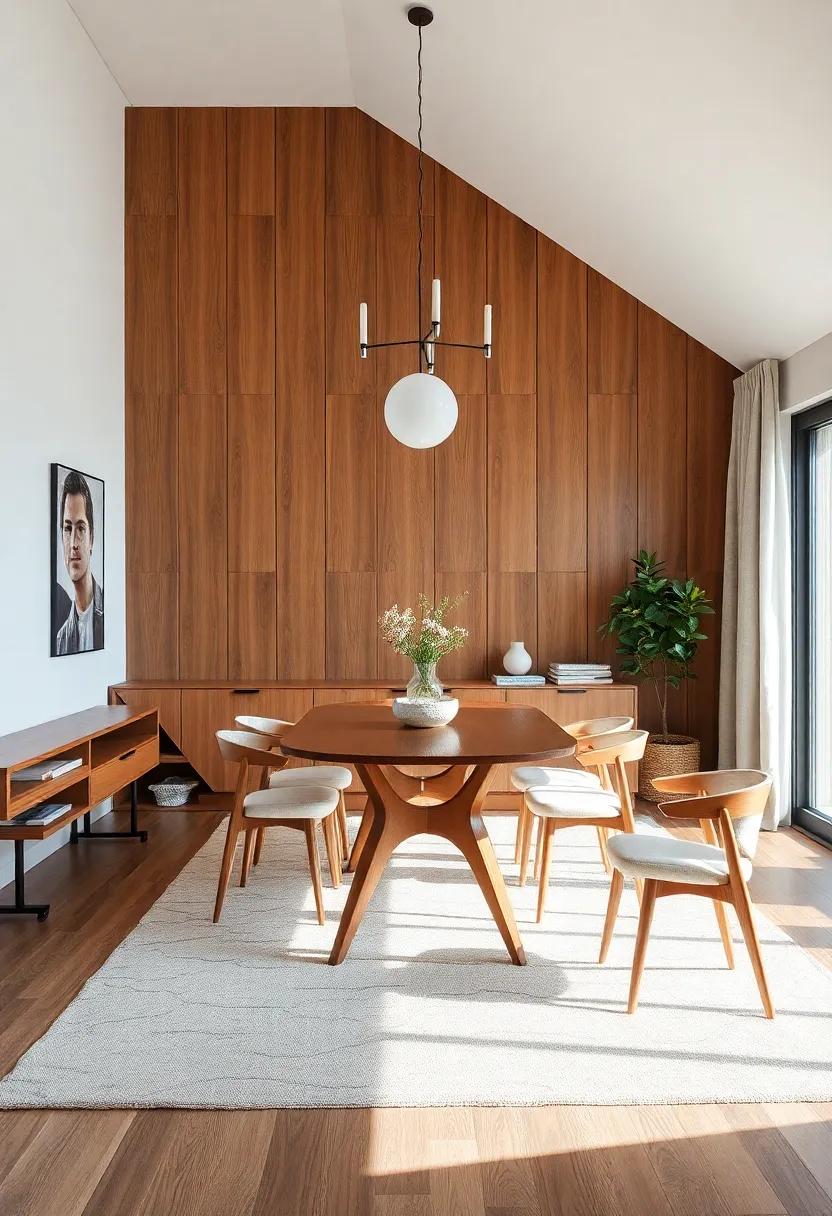
The allure of mid-century modern design lies not just in its clean lines and organic forms but also in the harmonious relationships between materials. Wood and fabric combinations evoke a sense of nostalgia, weaving stories into the fabric of your dining experience. Consider pairing warm walnut or oak tabletops with chairs upholstered in bold patterns or soft textures. This juxtaposition not only adds depth but also creates a tactile journey for anyone seated at the table. The natural grain of the wood tells a story of enduring strength, while the fabric choices can reflect personal style and mood, from cozy and inviting to refined and sophisticated.
In your quest to transform your dining space,let’s explore some captivating pairings:
- Teak and Boucle: Offers a rustic yet elegant vibe,perfect for a cozy dinner setting.
- Walnut and Velvet: Creates a luxurious feel,adding a hint of glamour.
- Ash and Linen: Provides a breathable, casual look ideal for everyday dining.
- Cherry and Wool: Gives warmth and texture, harmonizing elegance with comfort.
When considering these combinations,think about the stories that they tell. A beautifully crafted table can become a centerpiece while textured fabric chairs invite conversations that linger long after the meal is done. As you select your materials, remember to envision how each element interacts with the others, creating not just a dining area but an experience rich in character and warmth.
Accent Walls and Patterns: Enhancing the Visual Appeal of Your Dining Room
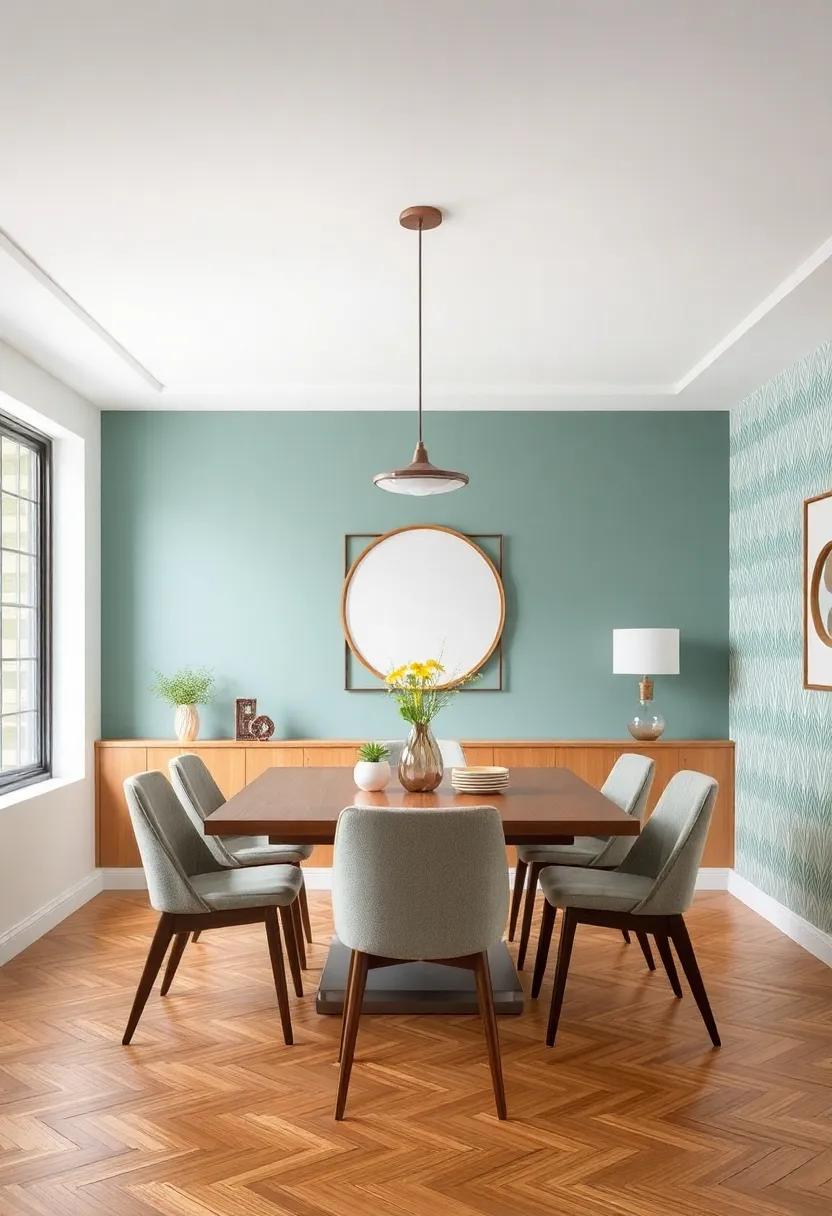
Incorporating an accent wall into your dining room can bring a refreshing twist to your design while celebrating the Mid-Century Modern aesthetic. Consider using rich,earthy colors such as olive green,burnt orange,or deep teal to evoke the warmth of this timeless style. To further enhance the visual drama, you can employ geometric patterns or bold textures. Wallpaper options featuring graphic designs or natural materials, like wood or stone, can complement the sleek lines and organic forms that characterize Mid-Century design. The strategic use of lighting on these feature walls can also highlight the patterns, enhancing the overall ambiance of the space.
For those looking to go beyond a single accent wall, consider incorporating all-over patterns or decorative elements that extend throughout the dining area. A beautiful table setting can feature decorative plates with mid-century motifs that echo the wall design. Here are some ideas to get you started:
- Wall Art: Use large-scale artwork to create a focal point that resonates with your chosen theme.
- Textured Fabrics: Integrate patterned table linens or upholstered chairs that complement your wall design.
- Unique Lighting Fixtures: Choose mid-century inspired pendant lights or chandeliers to unify the space.
lighting Fixtures as Focal Points: Embracing Vintage and Modern Styles
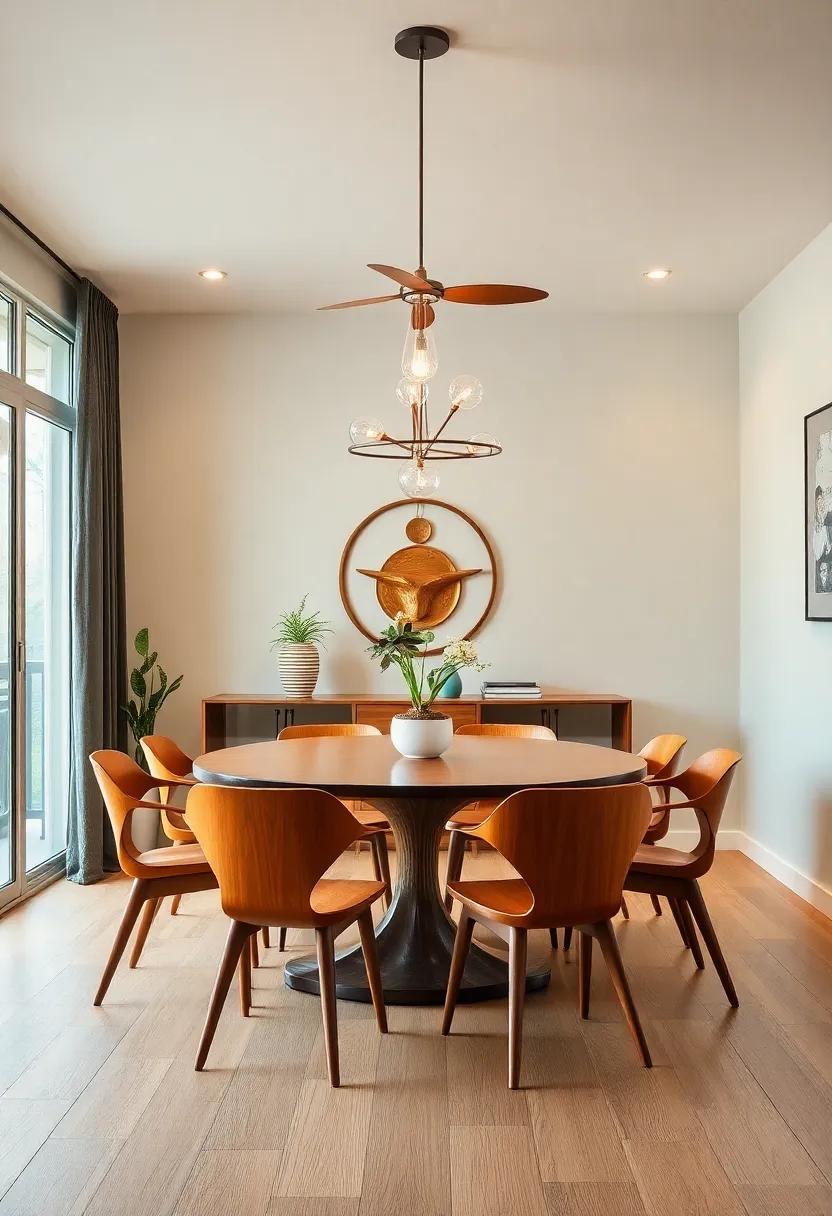
Incorporating lighting fixtures that serve as focal points can transform the ambiance of your dining room, blending both vintage charm and modern sophistication. Consider fixtures such as a mid-century modern chandelier or suspension lights that capture the eye while complementing the overall design. Here are a few types of lighting options that can elevate your space:
- Brass Finish Fixtures: These add a touch of elegance and a warm glow.
- Geometric designs: Bold, contemporary shapes that create visual interest.
- Vintage Pendant lights: Perfect for adding nostalgia and character.
- Adjustable Spotlights: Versatile for creating focused light and enhancing specific areas.
Pairing these lighting elements with carefully selected furniture can yield a stunning effect. As an example, harmonizing with a rustic wooden table or sleek modern chairs can create a balanced yet stylish look. To visually illustrate this, the following table showcases popular lighting styles along with their attributes:
| Lighting Style | Key Attributes | Ideal Pairing |
|---|---|---|
| Mid-Century Chandelier | Elegant, geometric design | Natural wood tables |
| industrial Pendant | Raw, minimalist style | Metallic accents |
| Art Deco Lamps | Vintage glamour | Elegant upholstered chairs |
Layering with Rugs: defining spaces and Adding Comfort in Modern Dining areas
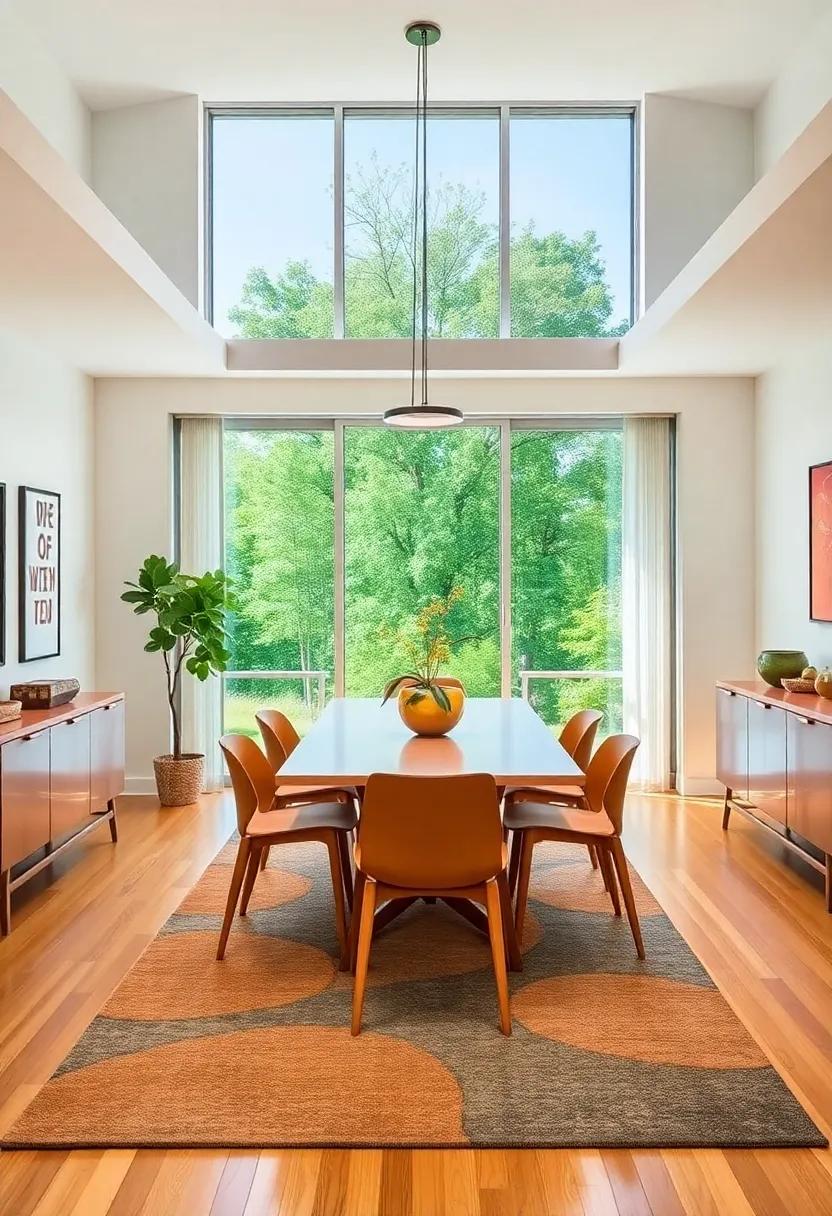
In the realm of modern dining design, the strategic use of rugs can create a sense of intimacy and warmth, transforming an open space into a cozy nook. By layering rugs, you can define different areas within your dining space, enhancing both aesthetics and functionality. Consider using a large area rug as the foundation, then layering a smaller, more textured rug on top to add depth. This technique not only brings visual interest but also creates a tactile experience underfoot that invites guests to linger longer. Choose rugs with bold patterns or rich colors that reflect your mid-century modern theme, allowing them to harmonize with furniture and decor seamlessly.
When selecting rugs, aim for varied textures that play well together; think sisal paired with a plush shag or a geometric print against a solid backdrop. These combinations can establish a well-balanced look that resonates with the mid-century aesthetic. Additionally, consider the dimensions of your dining area; an appropriately sized rug should extend at least 24 inches beyond the edges of your dining table to ensure all chairs sit comfortably without catching on the edges. Here’s a simple guide to help you visualize the space requirements:
| Table Size | Recommended Rug Size |
|---|---|
| 4-6 Seats | 5’x7′ or 6’x9′ |
| 6-8 Seats | 8’x10′ |
| 8-10 Seats | 9’x12’ or larger |
Art and Accessories that Reflect the Mid-Century Aesthetic in Dining Spaces
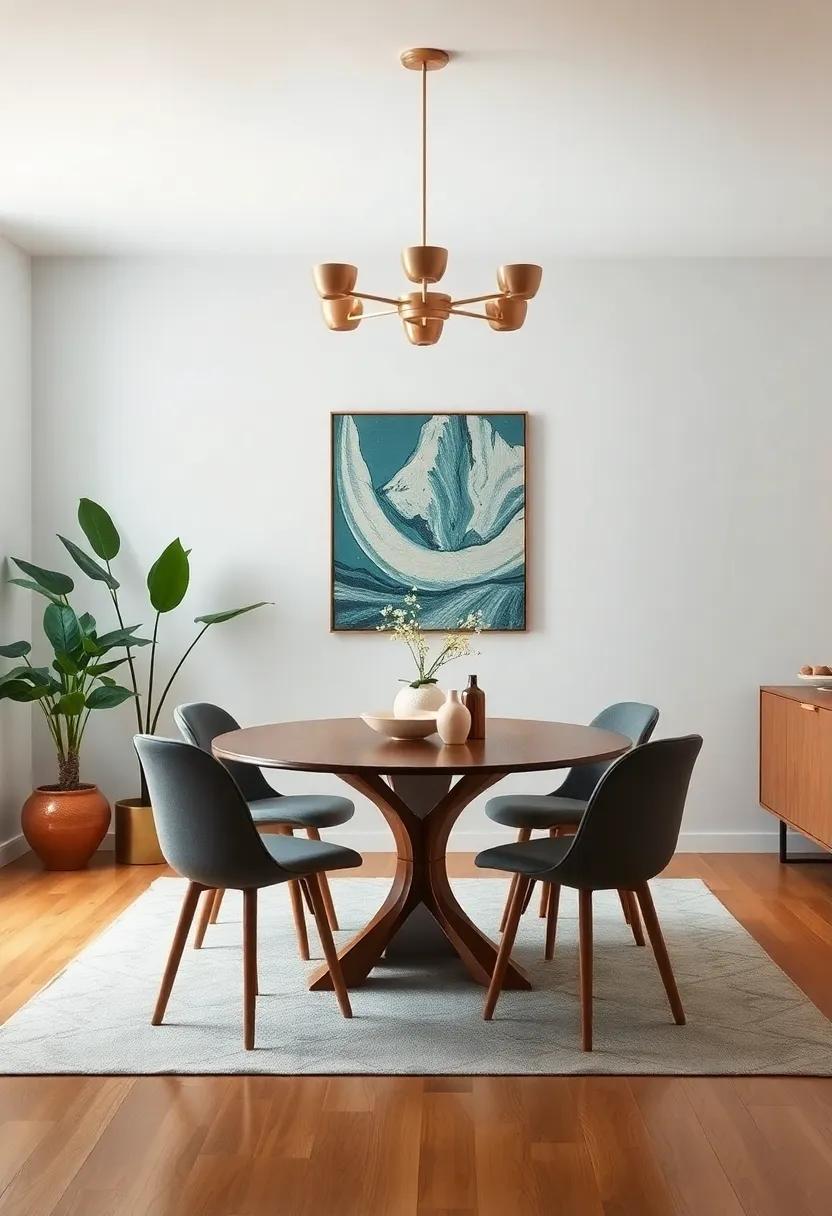
To fully capture the essence of mid-century modern design in your dining room,it’s essential to select art and accessories that resonate with the era’s unique aesthetic. Look for geometric patterns, organic shapes, and bold colors that accentuate the minimalist yet striking nature of the style. Wall art featuring abstract forms or iconic mid-century artists can serve as a stunning focal point. Consider incorporating the following elements:
- abstract Sculptures: Pieces made from wood, metal, or glass can add dimension and interest.
- Retro Tableware: Unique dishes or serving pieces in vibrant hues will elevate your dining experience.
- Textiles with Patterns: Tablecloths or cushions that showcase retro prints can provide warmth and color.
Additionally, consider using a thoughtfully arranged gallery wall that mixes both art and functional accessories. A perfect blend can be achieved using framed vintage prints and mirrors that echo the sleek lines typical of the mid-century era. Here’s a simple table to visualize how to combine these elements effectively:
| Accessory Type | Design Features | Color schemes |
|---|---|---|
| Wall Art | geometric shapes, abstracts | Bold primary colors, earth tones |
| Table Decor | Organic forms, minimalist | Pastel accents, jewel tones |
| Furniture Accents | Retro and sleek lines | Natural woods, bright enameled finishes |
Modern Dining Tables: Timeless Shapes and Materials that Inspire Elegance
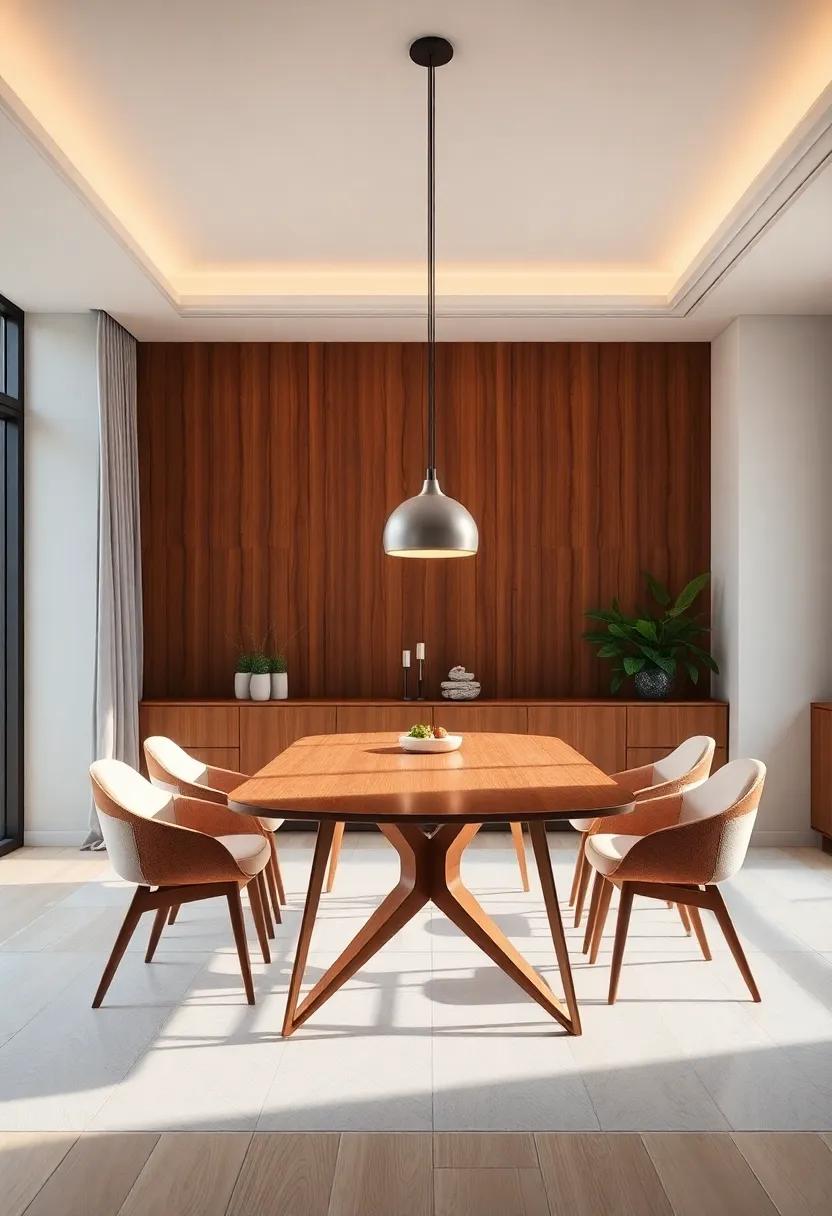
In the realm of dining room design, the revival of mid-century modern aesthetics has made way for an array of stunning materials and shapes that cater to both functionality and style. Wood, metal, and glass are frequently harmonized to create a visual contrast that invites both warmth and sophistication into the space. Tables with clean lines and organic curves bring a sense of tranquility, while rich grains of walnut or oak contribute a natural element that complements minimalist surroundings. These tables serve not just as furniture, but as a canvas for connection, where meals are shared and memories are made.
Contemporary dining tables have also embraced versatility, allowing you to switch between intimate gatherings and grand feasts with ease. With options ranging from extendable designs to statement pieces featuring bold hues, the right table can elevate your dining experience. Consider these popular shapes and their impact on space:
| Table Shape | Ideal For | Style Attributes |
|---|---|---|
| Rectangular | Large families,gatherings | Classic,formal |
| Round | Intimate dinners | Cohesive,friendly |
| Square | Small spaces | Balanced,modern |
| Oval | Versatile seating | Soft,inviting |
Seamless Indoor-Outdoor Transitions to Enhance Dining Space Experiences
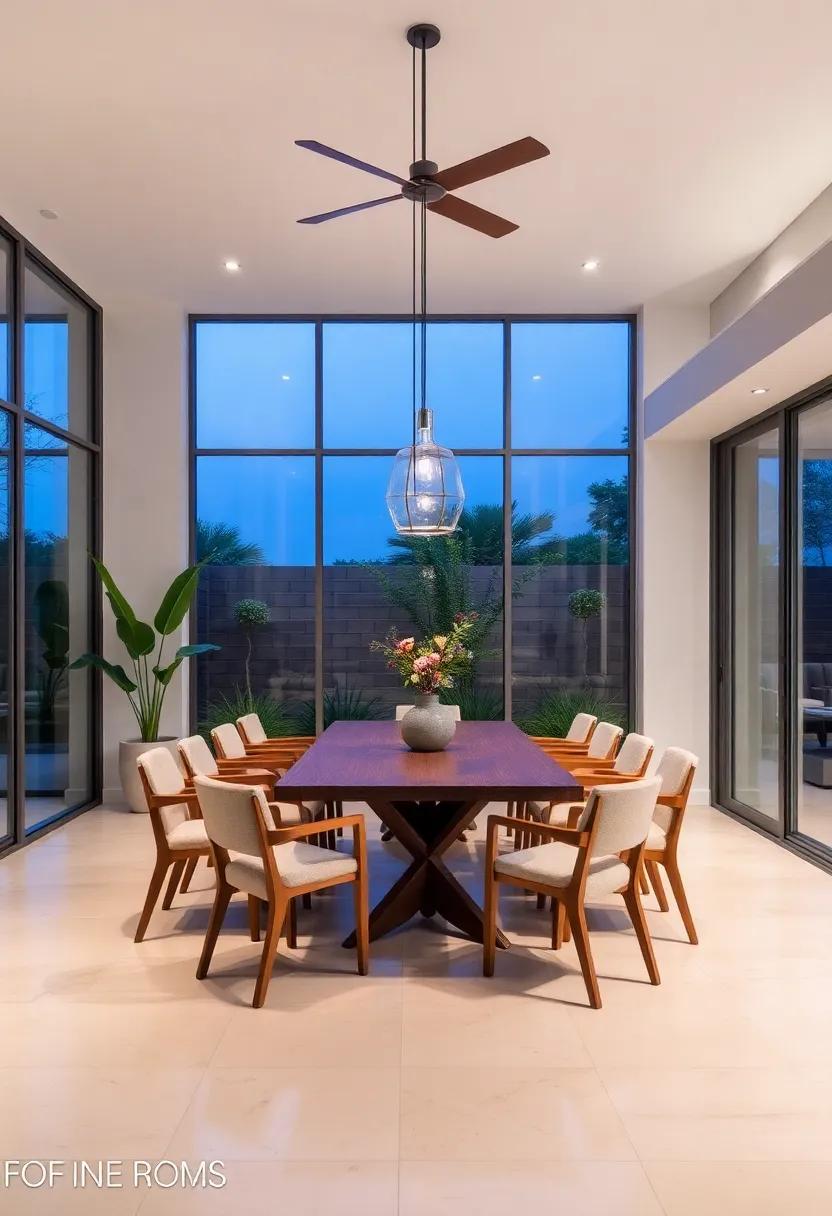
Creating a harmonious flow between indoor and outdoor spaces can significantly amplify your dining experiences. By utilizing large glass sliding doors or bi-fold windows, you can invite the beauty of nature into your home while maintaining the comfort of indoor dining. This design choice not only enhances the aesthetic appeal of your space but also allows for versatile entertaining options. Consider incorporating elements such as:
- Patio Dining Sets that complement your indoor furniture.
- Nature-Inspired Accents like potted plants or greenery that bridge the gap between indoors and outdoors.
- Textured Fabrics for cushions or table settings that echo the natural surroundings.
When planning your mid-century modern dining room, think about creating zones that seamlessly connect. A natural stone pathway or a wooden deck can serve as a transition area that enhances movement between spaces. Layering lighting is also essential; strategically placed fixtures can draw the eye through the transition points and create an inviting atmosphere. Consider the following approaches for a unified look:
| Feature | Impact |
|---|---|
| Integrated Flooring | Creates continuity from indoors to outdoors. |
| Matching Color Palettes | unifies the spaces, making them feel connected. |
| Outdoor Heating Elements | Extends the dining experience into cooler months. |
Statement chairs: choosing Unforgettable Styles for Comfort and Function
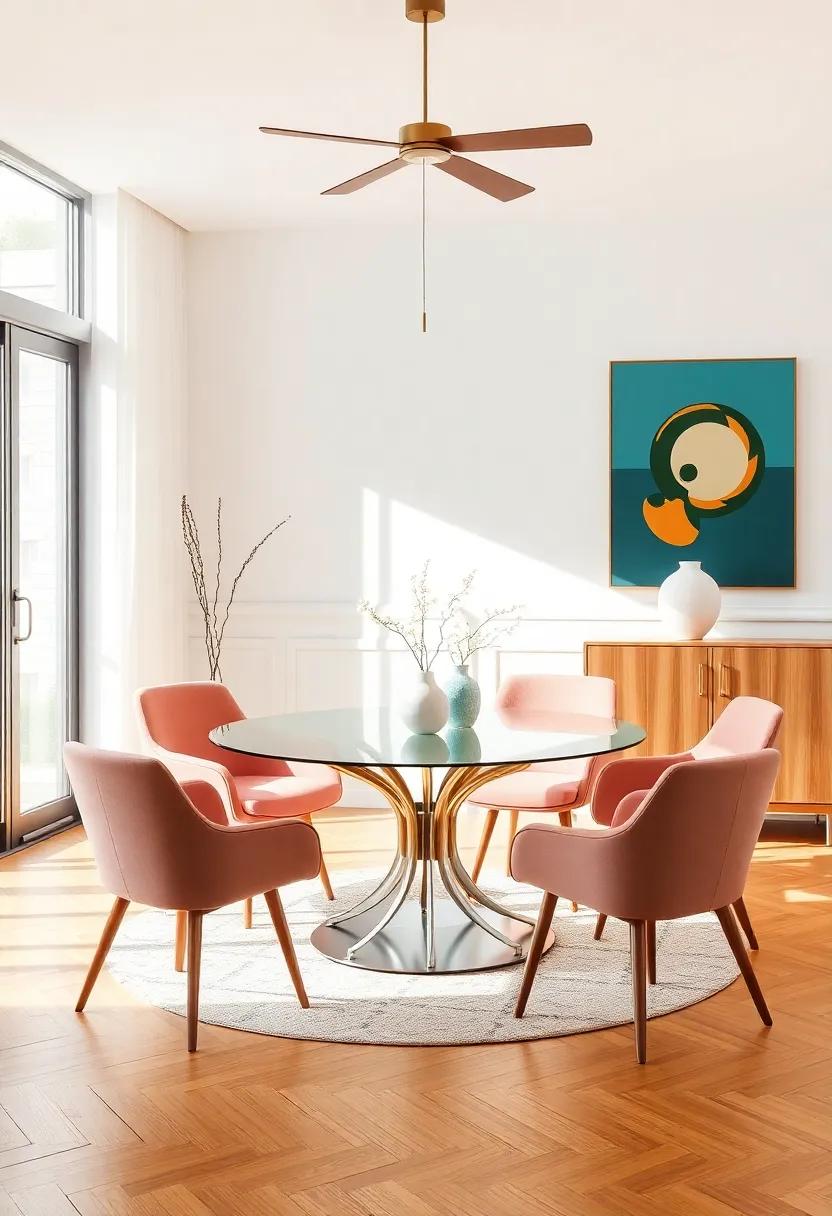
Statement chairs serve as the focal point of any dining room, seamlessly blending comfort with bold aesthetics. When selecting these standout pieces, it’s essential to consider not just their visual impact but also how they complement the overall design scheme.Embrace unexpected shapes and textures that invite conversation while providing a welcoming seat at the table. Some popular options to consider include:
- Wingback Chairs: Offering a classic silhouette with an elegant flair.
- Mid-Century Modern Models: Features clean lines and organic forms, perfect for a vintage touch.
- Bucket Chairs: Providing a cozy embrace, ideal for relaxed gatherings.
- High-Back Chairs: Adding sophistication and drama to your dining experience.
To achieve a harmonious balance between style and practicality, it’s essential to consider the materials used in these statement chairs. From luxurious upholstery to sustainable woods, each element contributes to the overall ambiance. Here’s a simple overview of material options that enhance both comfort and design:
| Material | benefits |
|---|---|
| Leather | Durable and easy to clean, exuding sophistication. |
| Velvet | Soft and plush, offering a luxurious feel. |
| Wood | Timeless and sturdy, adding warmth to the space. |
| Fabric | Infinite patterns and colors, allowing for personalized expression. |
Curating Functional yet Stylish Storage Solutions in Mid-Century Dining rooms
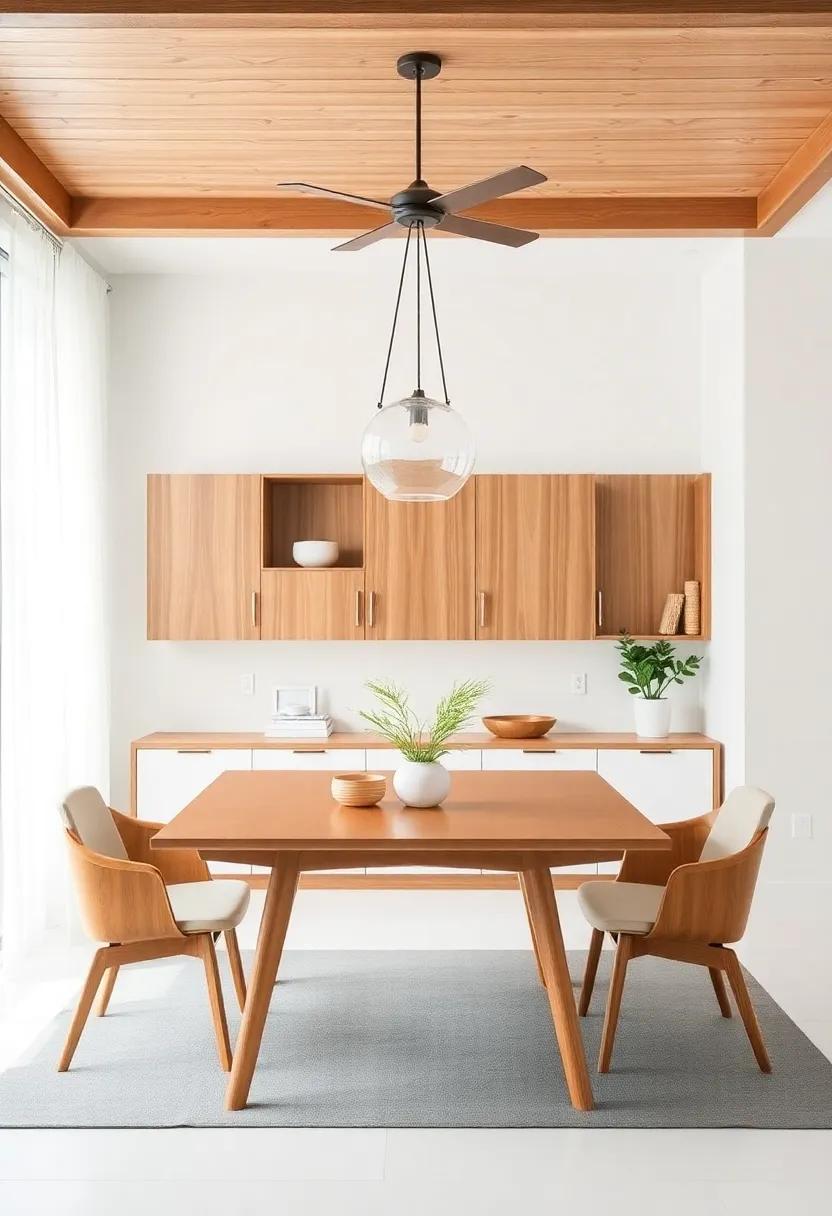
Incorporating storage solutions that blend functionality with style can elevate your mid-century dining room into a truly remarkable space. Opting for pieces that showcase the characteristic elements of the era, such as tapered legs and warm wood tones, allows for practical organization without sacrificing aesthetic appeal. Consider the addition of:
- Sideboards: These versatile storage units can house dinnerware while serving as a stunning display area for artful decor.
- Floating Shelves: Utilize wall space creatively; display cherished items while keeping surfaces clear.
- Buffets: A classic choice for serving and storage,often featuring sliding doors to conceal busy countertops.
When choosing these storage pieces, aim for designs that maintain an open and airy feel. Opt for light-colored woods or finishes that complement the iconic color palette of mid-century design, such as muted pastels or rich jewel tones. To help visualize the integration of functional pieces, here’s a simple table of essential items and their features:
| Storage Item | Key Features |
|---|---|
| Mid-Century Sideboard | Ample storage with clean lines and a timeless design. |
| Floating Wall Shelves | Maximizes space; easy access to decorative items or books. |
| Buffet Table | Ideal for dining service and hides clutter when entertaining. |
Color Psychology: how Shades Influence Your Dining Room Ambiance
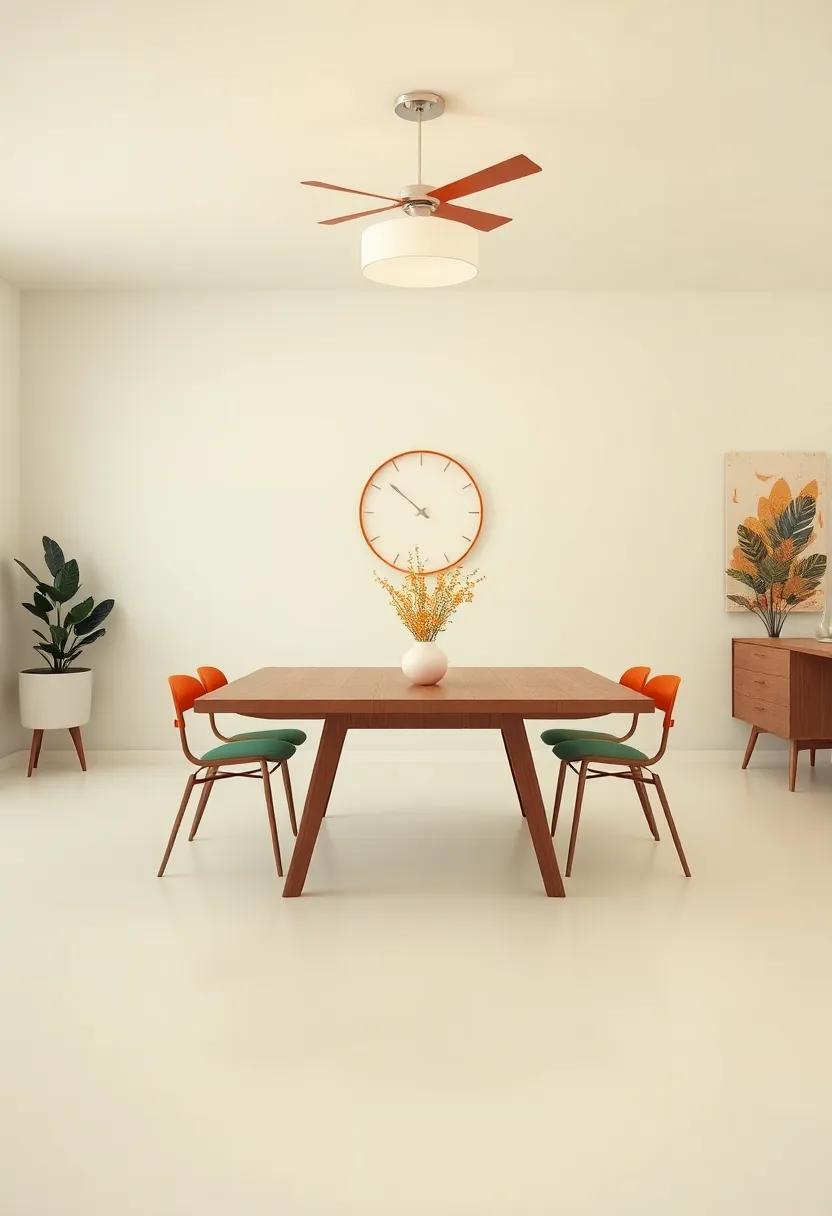
Color plays a pivotal role in shaping the mood and atmosphere of your dining room, acting as an unspoken language that sets the tone for social interaction.Warm hues like rich reds and golden yellows can create a cozy, inviting environment, making mealtimes feel more intimate. In contrast, cool shades such as soft blues and greens evoke a sense of tranquility, perfect for leisurely family dinners or casual gatherings with friends. By strategically selecting colors,you can transform a dining space into a lively hub or a serene retreat,depending on your personal style and the desired ambiance.
Here are a few shades and their psychological effects to consider for your dining room:
- Red: Stimulates appetite and conversation.
- Yellow: Encourages happiness and warmth.
- Blue: Promotes calmness and relaxation.
- Green: Represents freshness and balance.
- Purple: Adds a touch of luxury and elegance.
Incorporating these colors into your design can be achieved through various elements, such as wall paint, furniture choices, and decorative accents. Consider this illustrative breakdown of color combinations that harmonize beautifully with mid-century modern design:
| Color Combination | Effect |
|---|---|
| Soft Gray & Mustard yellow | Balance and warmth |
| Teal & Walnut Brown | Tranquil and grounded |
| Coral & White | Bright and cheerful |
| Navy Blue & Gold | elegant and sophisticated |
personal Touches: Incorporating Family Heirlooms into Your Mid-Century Design
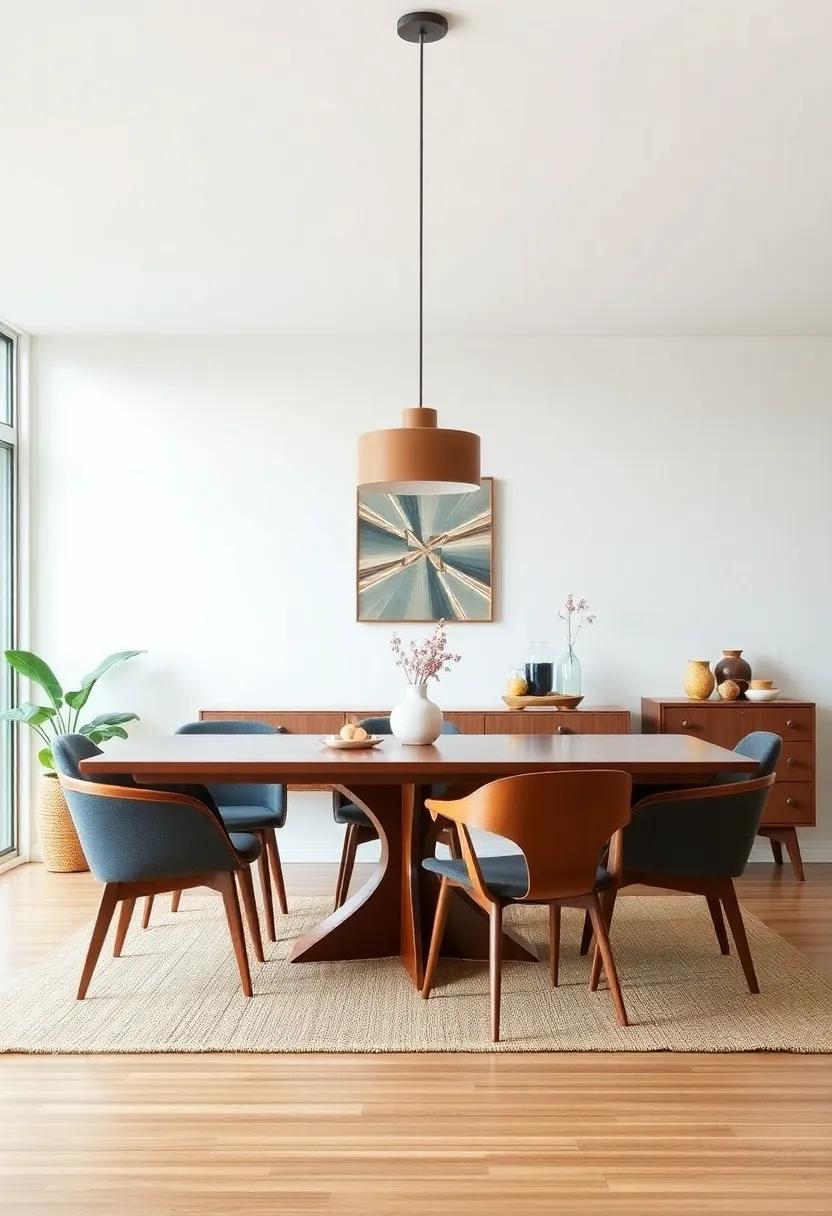
Incorporating family heirlooms into your mid-century modern dining room can infuse the space with warmth and personal history,creating a unique narrative that transcends mere décor. Whether it’s a vintage china set that has served generations or a beautifully crafted sideboard passed down through your family, these pieces add depth and character. Consider pairing your cherished items with classic mid-century elements like sleek wooden tables and sculptural lighting fixtures. This contrast not only highlights the heirlooms but also integrates them beautifully into your overarching design theme.
To seamlessly blend these heirlooms with mid-century aesthetics, you might want to focus on a few key strategies:
- Color Palette: Choose colors that harmonize with both your heirlooms and mid-century furniture. Earthy tones or muted pastels can create a cohesive look.
- Eclectic Arrangement: Don’t be afraid to mix styles. Strategically position your heirlooms beside more contemporary pieces to create visual interest.
- Showcase the Stories: Display these treasures prominently, perhaps on open shelves or as a centerpiece, to spark conversations about their history.
By thinking intentionally about how these heirlooms fit into your mid-century design, you create a dining room that is not only aesthetically pleasing but also rich in sentiment. The aim is to curate an environment where modern elegance intertwines with personal memories, turning your space into a reflection of both contemporary trends and treasured legacies.
Dining Room Layouts: Creating Flow and Space to Gather and Connect
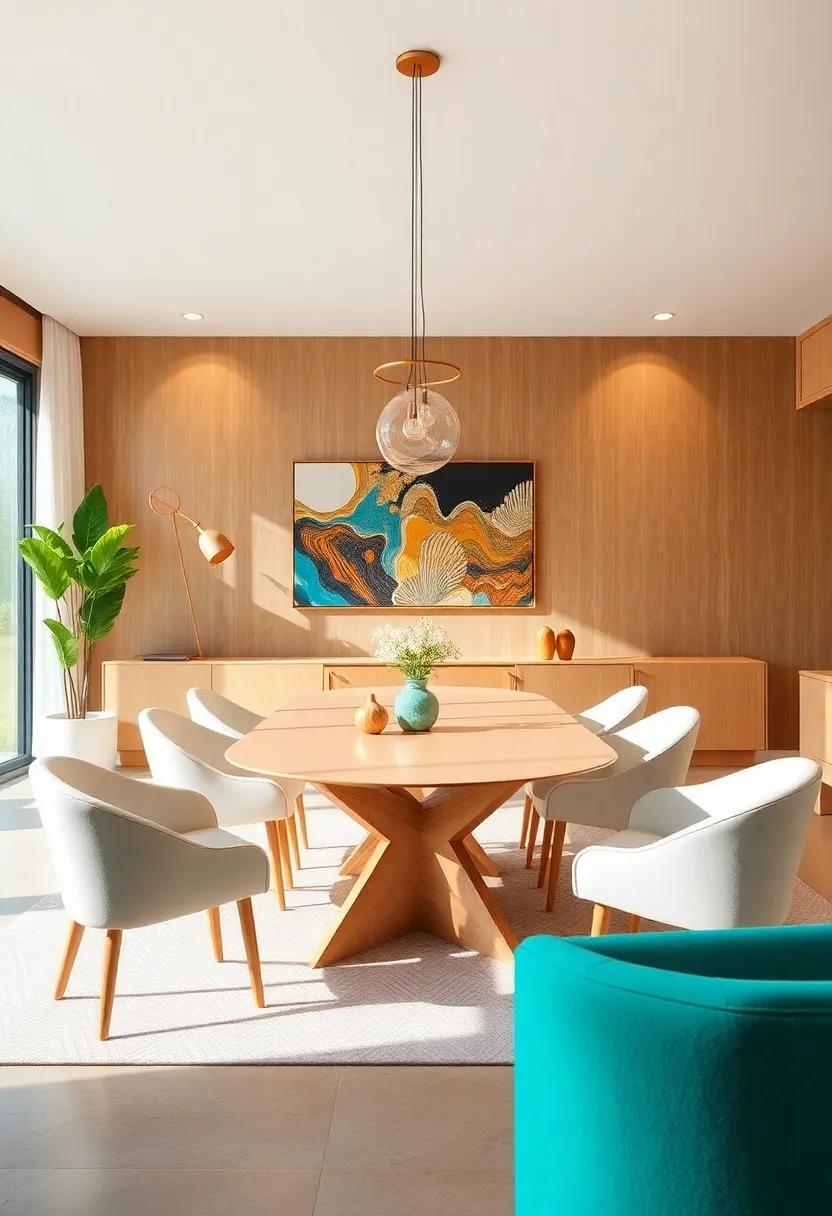
When designing a dining space that echoes Mid-Century Modern elegance,the layout is key to enhancing both aesthetics and functionality. Focus on creating a natural flow by arranging furniture that encourages conversation and connection. Consider these elements:
- Central Dining Table: A round or rectangular table serves as the focal point. Choose a design with clean lines and a warm wood finish to complement the overall vibe.
- Seating Options: Use a mix of upholstered chairs and minimalist benches to provide comfort while inviting guests to gather closely.
- Traffic Flow: Ensure pathways around the table are unobstructed, allowing easy movement without breaking the intimacy of the space.
Layers of texture and thoughtful decor can elevate your dining room’s inviting atmosphere. Incorporating elements such as:
- Natural Materials: Choose wood, stone, and metal accents that reflect the Mid-Century philosophy of harmony with nature.
- Lighting: Opt for pendant lights or sculptural fixtures that not only illuminate but also add a striking visual element overhead.
- Open Concept: If possible,merge your dining area with adjacent living spaces,enhancing connectivity and making the area feel more open.
| Feature | Benefits |
|---|---|
| Round Table | Facilitates conversation, creates an intimate dining experience |
| Flexible Seating | Adapts to group sizes, enhances comfort and accessibility |
| Natural Lighting | Brightens the space, enhances mood and well-being |
The Art of Table Setting: Merging Modern Elegance with vintage Charm
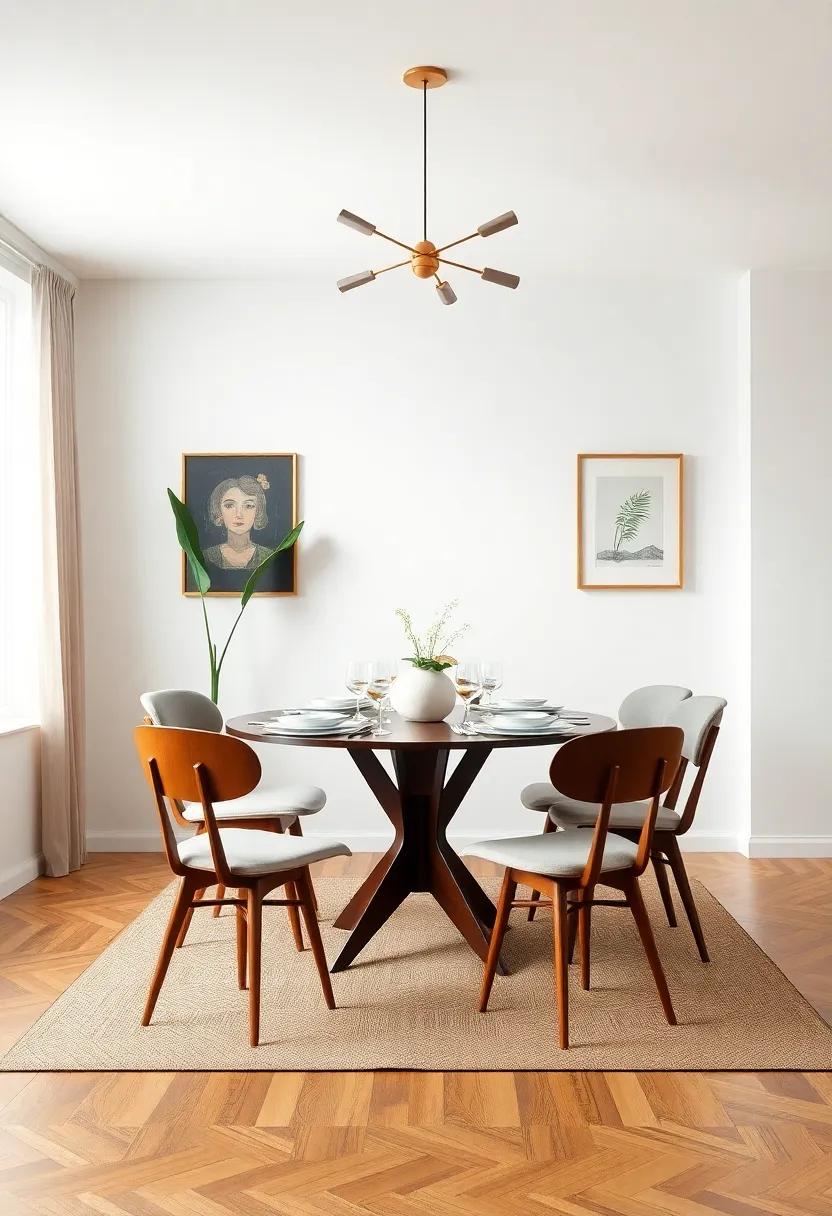
Setting a table that captures the spirit of both modern elegance and vintage charm requires a thoughtful blend of elements that elevate your dining experience.Choose a color palette that resonates with both eras; muted hues like soft greens, dusty blues, and warm neutrals can create a harmonious backdrop. For dinnerware, consider using handcrafted ceramics alongside sleek, minimalist dinner sets. Textured linens, such as lace or linen tablecloths, can add that touch of nostalgia, while contemporary flatware with clean lines gives a nod to current design trends.
layering your table setting is essential to achieve depth and interest. Incorporate vintage glassware that catches the light, juxtaposed with modern stemware for a sophisticated flair. Illuminate the scene with mid-century inspired candle holders or a statement chandelier that embodies both styles. don’t forget to add seasonal touches through practical elements like fresh flowers in eclectic vases, which can dial up both charm and elegance.
Greenery and Decor: Adding Life and Freshness to Your Dining Environment
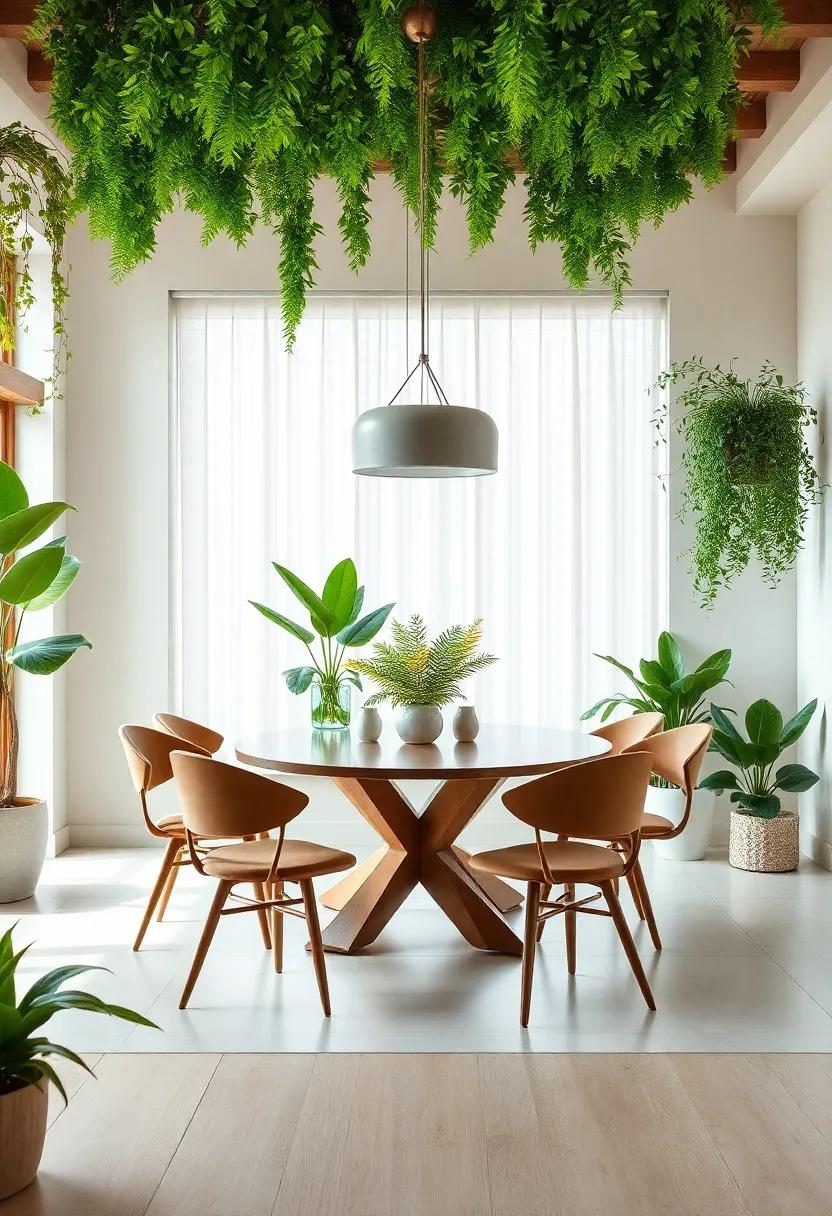
Incorporating elements of nature into your dining room can seamlessly enhance the overall aesthetic, elevating it to a serene yet stylish space.Consider lush indoor plants that bring a touch of greenery, creating a refreshing contrast against the wooden textures characteristic of mid-century modern design. Utilize items like:
- Succulents in chic planters
- Fiddle leaf figs for height and impact
- Herbs in stylish pots for aromatic benefits
these additions not only purify the air but also contribute to a cozy atmosphere. In addition,pairing these natural elements with carefully selected decor items can open up the space,making it feel more inviting. Think about minimalistic art pieces or handcrafted pottery that embody the mid-century aesthetic, arranged thoughtfully along the dining table. A charming centerpiece, perhaps a simple vase of fresh flowers, can draw the eye and create a harmonious blend between your dining furniture and the vitality brought by nature.
Exploring Iconic Artwork for a Touch of Personality in Mid-Century Dining Spaces

Incorporating iconic artwork into mid-century dining spaces is an excellent way to infuse personality and creativity into your home. Art from this era commonly features bold colors, geometric shapes, and abstract forms, making them perfect companions for the clean lines and organic curves of mid-century furniture.Consider the following elements when selecting pieces:
- color Palette: Look for art that echoes the vibrant hues of your dining furniture.
- Framing: Choose simple, minimalist frames that enhance rather than distract from the artwork.
- Theme: Opt for pieces that resonate with the overall aesthetic of your space, whether it’s playful, serene, or thought-provoking.
Displaying your chosen works can be done creatively, transforming blank walls into a gallery of mid-century masterpieces. One effective method is to curate a grid arrangement with various sizes and styles, ensuring balance and cohesiveness throughout the display.Additionally, consider hanging art at eye level, allowing for an engaging experience during meals. For those looking to invest in standout pieces, a simple comparison table may help visualize some renowned mid-century artists and their iconic works:
| Artist | Artwork | Year |
|---|---|---|
| Mark Rothko | No. 61 (Rust and Blue) | 1953 |
| Piet Mondrian | composition with Red,Blue,and Yellow | 1930 |
| Georgia O’Keeffe | blue Morning Glories | 1935 |
Visual Harmony: Mastering the Balance of Old and New in Your Dining Room
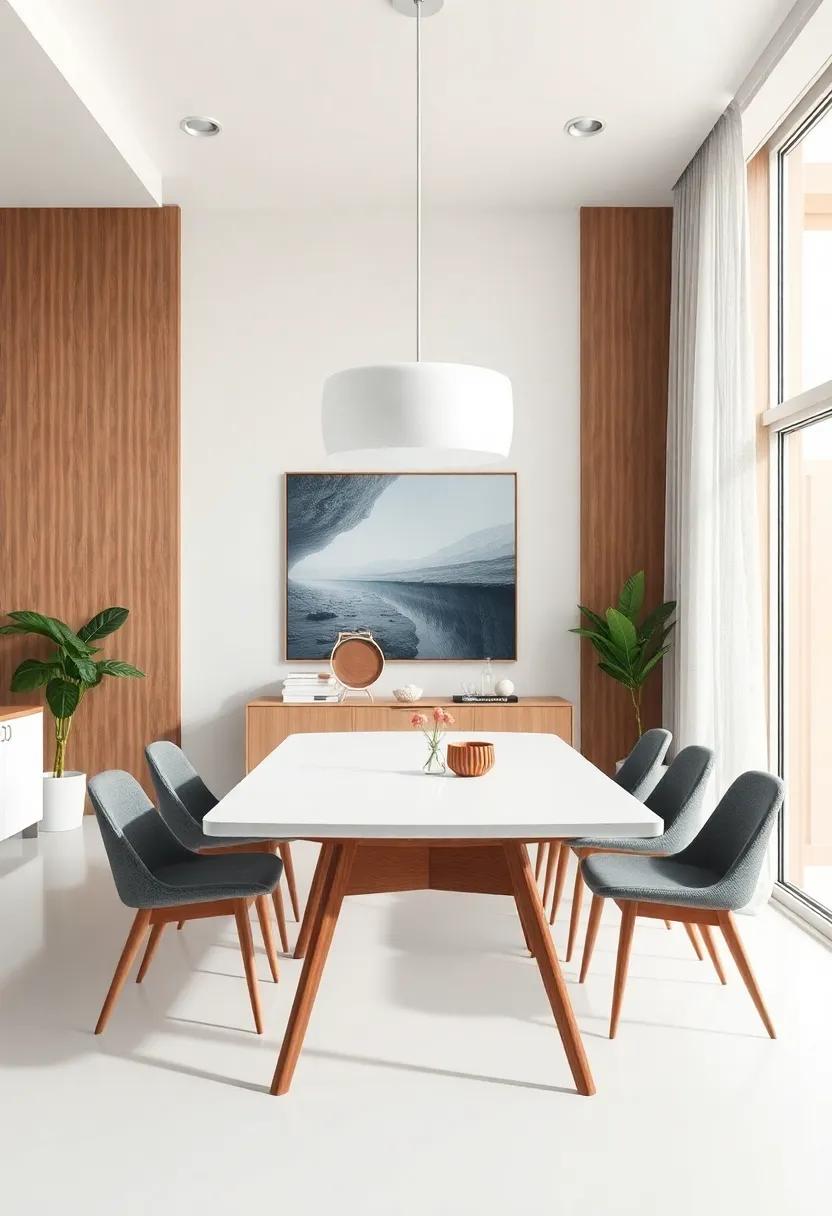
Incorporating both vintage and contemporary elements into your dining room creates a unique visual harmony that can enhance your space. To achieve this balance,consider selecting key pieces that symbolize the essence of each era. For example, you might pair a striking mid-century modern dining table made from rich, warm woods with sleek, minimalist chairs in a bold color. This juxtaposition invites curiosity and conversation, while the styles complement rather than compete with one another. Experimenting with textures, such as adding a fluffy area rug or layered textiles, will also help to create a welcoming ambiance that marries old charm with new sophistication.
When decorating,remember to incorporate elements that celebrate both eras.Here are a few suggestions to achieve a well-balanced aesthetic:
- Art and Accessories: Choose vibrant artworks that evoke both vintage images and contemporary styles. A bold abstract piece can play nicely against classic ceramics.
- Lighting: Mix retro pendant lights with modern sconces or table lamps to create varying levels of illumination that enhance the overall design.
- Color Palette: Use a cohesive color scheme that incorporates classic tones like muted greens or warm browns while adding splashes of contemporary colors like teal or mustard.
Consider placing a small table showcasing unique collectibles alongside newer items to bridge the gap between eras seamlessly.Here’s a fast comparison of decorative elements that work well together:
| Vintage Decor | Modern Decor |
|---|---|
| Antique china sets | geometric dinnerware |
| Chandeliers with a patina finish | Clean-lined LED fixtures |
| Classic wooden buffets | Metal and glass sideboards |
By thoughtfully layering these distinct elements, you can create a dining room that tells a story and bridges generational design influences, offering a rich visual experience for anyone who enters the space.
Celebrating Mid-Century Craftsmanship: Choosing Quality Over Trends
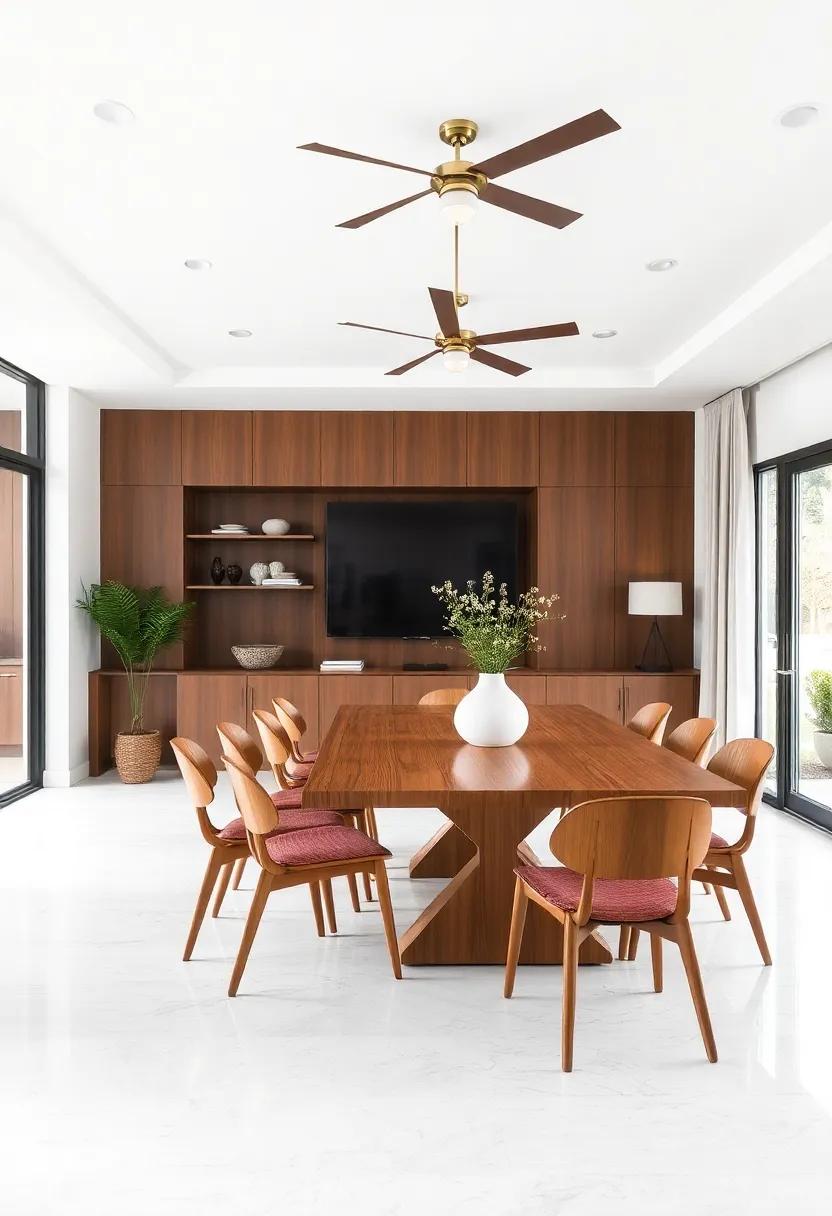
As we explore the influence of mid-century craftsmanship within dining room design, the emphasis on quality materials shines through.The mid-century era celebrated an aesthetic that prioritized function alongside form, seamlessly blending elegance with everyday usability. Furniture pieces from this time were often made from rich woods, like teak and walnut, which not only convey warmth but also promise durability that outlasts fleeting trends. when choosing your dining table or chairs, consider artisans who uphold traditional techniques, ensuring that each piece can tell a story and endure the test of time.
incorporating mid-century modern elements into your dining area allows for a harmonious balance of simplicity and sophistication.Think about integrating standout features such as:
- Sleek lines that enhance the overall flow of the space.
- Bold colors that add personality without overwhelming the senses.
- Textured fabrics that invite comfort and enhance tactile experiences.
By focusing on these timeless elements rather than temporary fads, you evoke a sense of nostalgic elegance that enriches not only your dining space but also the experience of gathering around the table.
Transformative Accessories: Small Elements That make a Big Impact in Dining Design
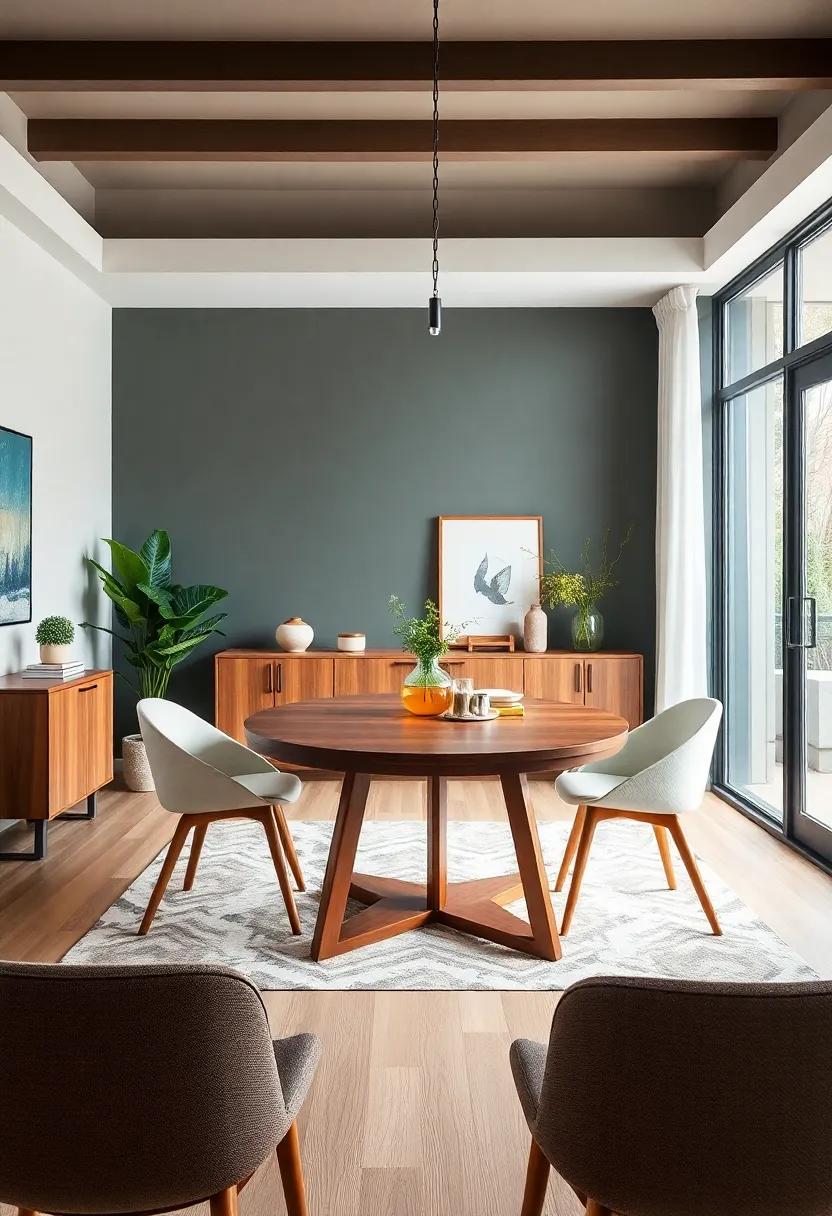
when reimagining your dining space, it’s often the seemingly minor details that can create significant stylistic shifts. Embracing transformative accessories allows you to add a personal touch while juxtaposing the clean lines and organic forms characteristic of Mid-Century Modern design. Consider decorative tableware that reflects retro aesthetics—think vibrant ceramic bowls or angular glassware that adds an artistic flair. Layering textures is another key element; incorporate linen or cotton table runners alongside polished wooden surfaces to create a captivating interplay of materials.
Adding unique elements such as eye-catching lighting fixtures or bold artwork can also contribute to the overall charm of your dining area.Wall-mounted sconces in brass or matte black can evoke the era’s sophistication, while a central pendant light can enhance your table’s visual appeal. If space allows, a well-placed credenza not only serves as practical storage but provides an possibility for decorative displays, such as vintage books or a curated collection of dinnerware. These thoughtful accessories not only provide functionality but also serve as conversation starters, enveloping your guests in the timeless elegance of your curated Mid-Century Modern dining experience.
Key Takeaways
As we conclude our exploration of mid-century modern elegance in dining room design, it’s clear that this timeless aesthetic is more than just a trend; it’s a celebration of form, function, and a harmonious balance between the past and present.By integrating clean lines, organic shapes, and vibrant colors, your dining space can become a sanctuary of style and comfort. Remember, the essence of mid-century modern design lies in its versatility—whether you’re revamping an existing space or starting from scratch, the key is to embrace your unique personality and let it shine through. So go ahead, unleash your creativity, and transform your dining room into a haven of elegance that not only reflects your taste but also serves as a backdrop for countless cherished moments. Happy designing!
As an Amazon Associate I earn from qualifying purchases.

